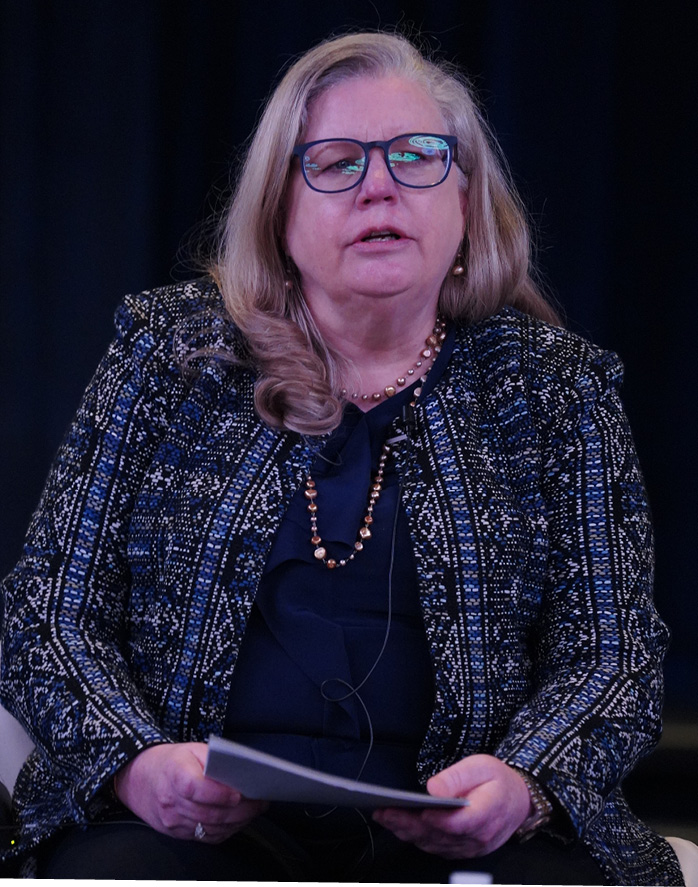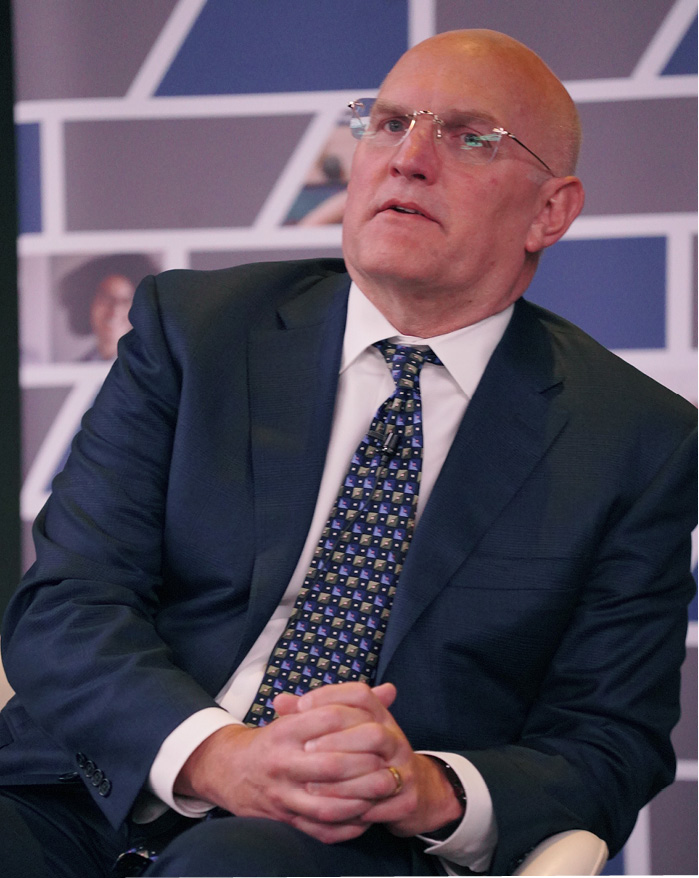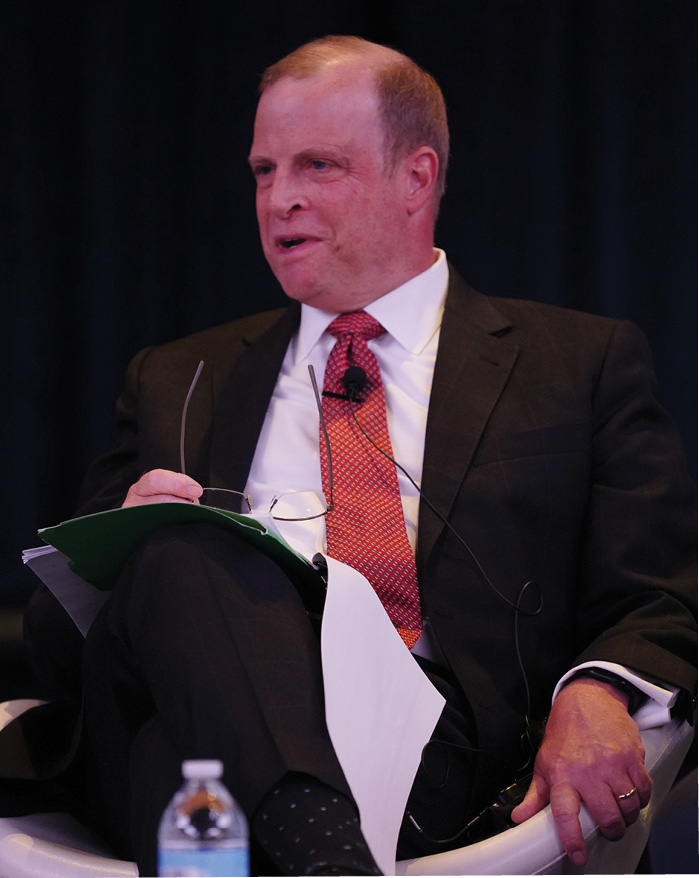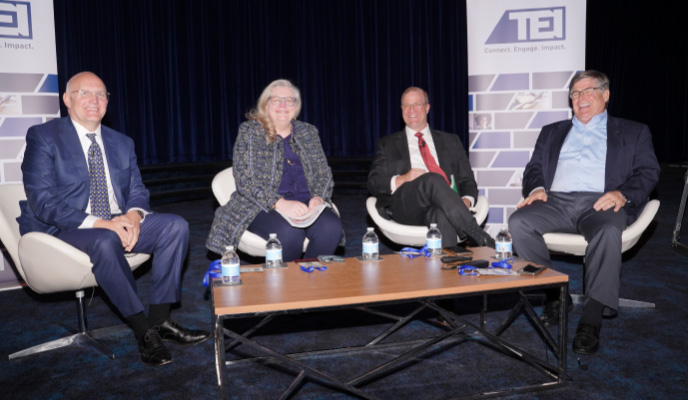In an engaging and educational Annual Conference session moderated by Cliff Mangano, chair of TEI’s IRS Administrative Affairs Committee, a panel of experts discussed recent developments and trends in global tax policy and controversy.

The experts included Scott Frewing, tax partner in the Palo Alto office of Baker McKenzie, who litigates large tax disputes, including as the lead attorney for Facebook in a major transfer pricing case in tax court; Barbara Angus, EY’s global tax policy leader, based in Washington, D.C., who previously served as chief counsel for the House Ways and Means Committee during the consideration of the Tax Cuts and Jobs Act; and Paul Schmidt, chairman of BakerHostetler and former head of its tax group.
Angus focused on the second phase of the Organisation for Economic Co-operation and Development’s base-erosion and profit shifting project (BEPS 2.0), which she called “a global tax policy project like no other we’ve seen before.” Beginning in 2019, 143 jurisdictions have been participating in the project, following what Angus considers an aggressive timeline. BEPS 2.0 is not only very complex, she noted, but also applies to fundamental aspects of both international tax policy and countries’ domestic tax policy. Pillar One aims to change the nexus and profit allocation rules to allocate more profit to market jurisdictions—and therefore less profit to certain other jurisdictions, she said. “And then with Pillar Two,” she added, “you have the fifteen percent global minimum tax rules.”
Pillar Two
“When the project began in 2019,” Angus explained, “it’s fair to say that Pillar Two, the global minimum tax rules, seemed a little bit like the neglected sibling of the project. But since then, it has leapfrogged Pillar One, and today we are two and a half months away from the first Pillar Two minimum tax rules taking effect around the world. So, there has been a whole lot of activity with respect to Pillar Two over the past year to eighteen months in terms of the global negotiations of the design and the technical details. And over the past year, there’s also been a huge amount of activity in countries around the world in terms of their implementation of those Pillar Two rules.”
Today, Angus noted, Pillar Two has model rules, with 300 pages of accompanying commentary and two tranches of administrative guidance. “All of those documents are what countries have committed to use,” she said. “If they choose to enact global minimum tax rules, they’ve committed to do it based on what is reflected and has been agreed [to] in all of those documents. So, they are really important. But it is a very complex base, when you think about it in terms of individual countries’ legislation and regulations that are supposed to be consistent. I think another important point is we saw the second tranche of administrative guidance in July. They are working on additional administrative guidance, so that will be an ongoing process. The administrative guidance is described as ‘clarifying’ key points in the model rules and commentary, but really the administrative guidance in many cases goes beyond clarification.”
Safe Harbor Rules
Three sets of safe harbor rules exist now, Angus noted. “Two are temporary transitional safe harbors, and one is permanent, and they’re all aimed at easing the compliance burdens with respect to Pillar Two, allowing simplified calculations,” she explained. “The most immediate of the safe harbors, which is an important one, is being able to do the calculations of potential top-up tax liability based on using data from your country-by-country reports instead of doing the full Pillar Two calculations. So, that simplified calculation can get you to a different result. It could show you not owing top-up tax where top-up tax might have been owing, but probably more significantly it just is much easier—it’s complicated, but an easier calculation than the full calculation.”
GloBE Information Return
There is also a template for the GloBE (global anti-base erosion) information return or GIR, a common return to be used by all countries to show all of the pillar, Angus pointed out. “Two calculations, and it is a monstrous information return. There are a hundred or more data points for each jurisdiction to do the Pillar Two calculations, so a very complex form, which each country is to implement consistent with that form. It’s to be filed with each country where you have operations, and it will then show whether in each country you have top-up tax liability or not, but you’ve got to do the form either way. There is a mechanism for centralized filing to file the form with one country, and that country will share it with the countries that it has information-exchange relationships with. So that potentially significantly simplifies the filing, but you still have to do separate filings with any country that doesn’t have an information-exchange relationship with the country where you filed it.”

The GIR is an important document, she noted. “Right now, it’s not expected that the US will implement the GloBE information return,” she said. “They did implement the country-by-country reporting a few years ago using reg authority that they had, but the information in the GloBE information return—because the Pillar Two calculations are unlike any other tax calculation, they’re based on financial statement numbers with myriad specialized adjustments—it’s hard to say that that information on the GloBE information return would be useful to the IRS if we don’t have—and we don’t have—Pillar Two rules in the US. And so that means that US-based companies, if they want to use the centralized filing mechanism, they need to find a country where they have operations, where they’re comfortable with the tax authority there.”
Schmidt asserted that it was probably important to US taxpayers for the United States to be the custodian of this information. “With Pillar Two not being adopted by the US, or not likely to soon,” he said, “we are going to be in a situation where you’ve got yet one more layer of information reporting—very detailed information reporting—and you’re going to have to go find another jurisdiction to do that.”
More administrative guidance is expected, Angus noted, a process likely to continue after the Pillar Two rules are up and running, as the 143 countries identify unanswered questions and try to find some way to reach agreement on guidance. “Maybe the most important thing that’s still to come is the peer review process,” she said. “The global minimum tax rules are a set of three different rules that give different countries the first, second, and third bite at the apple of imposing the top-up tax so that you don’t have overlapping or duplicative top-up taxes, and the rules then work by the country’s rules that they enact have to be qualifying in order to fit within that ordering rule. And so, they’re looking at the inclusive framework, the 143 countries that have been designing this, to have a peer review process that will make a determination as to whether each country’s rules are qualifying. I think that’s an immediate thing they need to do, but they also, I think, will have some difficult things to navigate going forward, because there’ll be a lot of questions about interpretation and application.”
Finally, Angus noted, several countries and jurisdictions have announced plans to enact Pillar Two, but not before 2025. “That includes Singapore and Hong Kong, the Channel Islands, South Africa, and Thailand,” she said. “So, even though everyone is supposed to be doing this consistently, there’s a lot of differences to continue to monitor. That creates a lot of complexity for multinationals that are subject to these rules anywhere. The rules that exist in any country where they do business could apply to tax the income they earn anywhere else. And there’s a huge amount to do to get ready for Pillar Two rules. The data intensity, the data that needs to be collected includes data not usually maintained by the tax department. And then, as you look forward, and sort of flipping to the second part of our panel, the potential for complex multilateral controversy with respect to Pillar Two with no multilateral instrument to use for dispute resolution is, I think, really daunting.”
Frewing doubted that the United States would enact legislation to comply with Pillar Two anytime soon. “The nearest is you have 2025, and in 2025, we have a lot of expiring provisions from the 2017 tax act, and you may have a new Congress,” he said. “And so what you need, I think, is a clean sweep by the Democrats. I think they would need to have the White House and the House and the Senate in order to get us compliant. Short of that, I think it’s all going to be dependent on the White House and what they decide to do to interpret it. So, I think it’s going to be a long stretch from the US. And it’s sort of an interesting thing, because [the United States] started out as sort of a leader on this.”
Angus noted that it’s not tax savings to any taxpayers; it’s just that US GILTI taxes and other US taxes will be replaced by higher foreign taxes in various countries. Schmidt agreed: “Even if the US ended up enacting it, [the Joint Committee on Taxation] was estimating a $57 billion outflow from the Treasury, so you really wonder how we got here, how we got in this mess. But it’s coming.”

But the consequences could be worse if the United States did not enact it, Frewing said: “The Joint Committee has estimated that if the US doesn’t participate, it could cost in the next ten years $122 billion of outflow of US revenue. That’s a big number when you think about it. That’s because of the fact that the rest of the world is going to be increasing their taxes at our expense.”
Concerning Pillar Two, Schmidt said, “It’s minimum tax and Pillar One is nexus, right? I mean, let’s face it; there is the reality that much of our nexus standards around the world, a permanent establishment standard, evolved at a time when bricks-and-mortars, factories, were the way you determined taxation. So, there is a challenge, right? There is a challenge in the new digital economy. But there’s also a question of what about the source, the country that invested in the R&D necessary to develop that intellectual property, and what are those rights? I think this is a question of, Does the permanent establishment standard still stand up? I think it’s an admission that the arm’s-length standard has a lot of flaws when it comes to this approach. But at the end of the day, if this doesn’t go forward, there’s going to be these [digital services taxes] cracking back up like weeds.”
The Moore Case
Angus turned to a current case before the US Supreme Court, Moore v. United States, which, she said, captured tax professionals’ interest by its calling into question the basics of the Internal Revenue Code itself, including its definition of income. She pointed out the coincidence that the government filed its brief on October 16, the sixty-first anniversary of President Kennedy signing Subpart F into law in 1962.
Frewing found the concurrence of the two events interesting, given that the date marked the world’s entry into a global tax regime and now into a territorial tax regime.
Global Tax Policy
As the conversation shifted, Schmidt noted that the world’s top taxation dispute is transfer pricing. “You’ll see foreign authorities argue about permanent establishment and nexus, but it always devolves into transfer pricing disputes, and there’s more transfer pricing disputes around the world than anything else,” Schmidt said. “If you think about it, when you think about the OECD and think about BEPS, base erosion and profit shifting, there are two ways to do it primarily. One is transfer pricing, and the second is location of debt. If you think of those two things, you’ve dealt with most of BEPS. I think about that as something really, really important on a global basis. In the US, we have [Section] 482. And 482, as Scott was pointing out, goes hand-in-glove a lot of times with economic substance, because it is another tool that the IRS can raise in these disputes. I note that when you look at the statute itself in 482—and interestingly, in the Xilinx case, which was really a transfer pricing case and a question of whether stock options are considered in a cost-sharing agreement, the first Ninth Circuit opinion that came out—and there were two; it reversed itself—but the first Ninth Circuit opinion was very quick to note that Section 482 doesn’t speak in terms of the arm’s-length standard. Rather, it talks about the prevention of evasion of tax and clear reflection of income. And that’s very broad.”
Frewing said that while there was no precise right answer on transfer pricing, he thinks taxpayers should be reluctant to throw away the arm’s-length standard or to let governments throw away the arm’s-length standard. “The reason why Treasury introduced the arm’s-length standard, not the statute, was because people really do intuitively want to look to market transactions,” he said. “It may not be that there’s a perfect market transaction for every single transaction that you have in a company, but on the other hand, virtually every transfer pricing decision for the last sixty years has tried to look to market transactions, because what else do you look at? If you don’t have something to look at to compare yourself to, you’re really untethered from anything. I think taxpayers should be reluctant to give up the arm’s-length standard. And it’s in all of our treaties; it really does form the basis of how we think about things. It’s right that it’s not talismanic. You don’t know exactly where to land, but at least it gives you something that rational people can usually get to a range about. Somewhere in this range, there’s an economic outcome that makes sense.”
Schmidt noted that not all of these cases result in litigation. “There’s still a lot of resolution of transfer pricing disputes at the administrative level. But even ones that do, at the end of the day the taxpayers are faring fairly well. The odds are not bad for the taxpayers to fight over this, and so I think it’s really worthwhile. And then, of course, the stakes are high.”
Frewing agreed that the stakes are high. After Coca-Cola, the ability to settle transfer pricing appeals got harder just because of one decision. “In the Meta case,” he said, “they filed a brief four months after Coca-Cola saying it was controlled by Coca-Cola, even though it was not a cost-sharing decision. They liked that decision a lot.”
Schmidt summarized the discussion: Appeals is still a very, very good forum. “It’s worth going to; it’s worth a try,” he said. “It is not as independent as it used to be, especially because it can’t consider all the avenues. You have to know, going in, that Appeals is an arm of the IRS and take it for that. But it’s still sort of worth the shot. Exam is now emboldened. They are empowered to act to raise soft doctrines, and soft doctrines are very, very hard, economic-substance-intense, business purpose, step transaction. And they will. I do think that that ultimately leads you to the notion that settlements are more difficult, so that would tend to lead toward likely more litigation unless there’s other advanced mechanisms for resolution. APAs may be one of those. They’re difficult; they’re time-consuming.”




